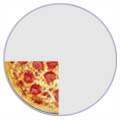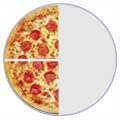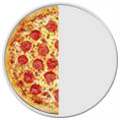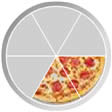Step 1. The bottom numbers (the
denominators) are already the same. Go straight to step 2.
Step 2. Add the top numbers and put the answer over the same
denominator:
| 1 |
+ |
1 |
= |
1 + 1 |
= |
2 |
|
|
|
|
| 4 |
4 |
4 |
4 |
Step 3. Simplify the fraction:
In picture form it looks like this:
(If you are unsure of the last step see
Equivalent Fractions.)
Example 2:
Step 1: The bottom numbers are different. See how the slices are different sizes?
We need to make them the same before we can continue, because we
can't add them like that.
The number "6" is twice as big as "3", so to make the bottom
numbers the same we can multiply the top and bottom of the first
fraction by
2, like this:
| × 2 |
 |
 |
| × 2 |
Important: you multiply both top and bottom by the same amount, to keep the value of the fraction the same
Now the fractions have the same bottom number ("6"), and our question looks like this:
The bottom numbers are now the same, so we can go to step 2.
Step 2: Add the top numbers and put them over the same denominator:
| 2 |
+ |
1 |
= |
2 + 1 |
= |
3 |
|
|
|
|
| 6 |
6 |
6 |
6 |
In picture form it looks like this:
Step 3: Simplify the fraction:
In picture form the whole answer looks like this:




















![*[ NOTA PENGAJARAN DAN PEMBELAJARAN ]*](https://blogger.googleusercontent.com/img/b/R29vZ2xl/AVvXsEiHxUHhLq34pRMpVRGwiF51pyvC7JJxHM4KP8Hd0-eys5qk5rcxSVddaZcsfy-aId0JdmPc3jv-cSpOIGYFhd63ImnzLHjMQMvzgMoZLw3ywNb7DyDlh0bX_KW-HsyU3dfbAtiQ4zygdxQ/s970/MATH+TEACHER+ONLINE+WITH+FRAME.jpg)
No comments:
Post a Comment